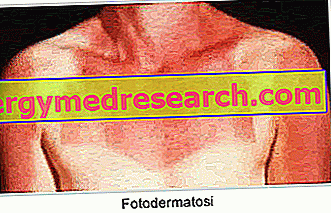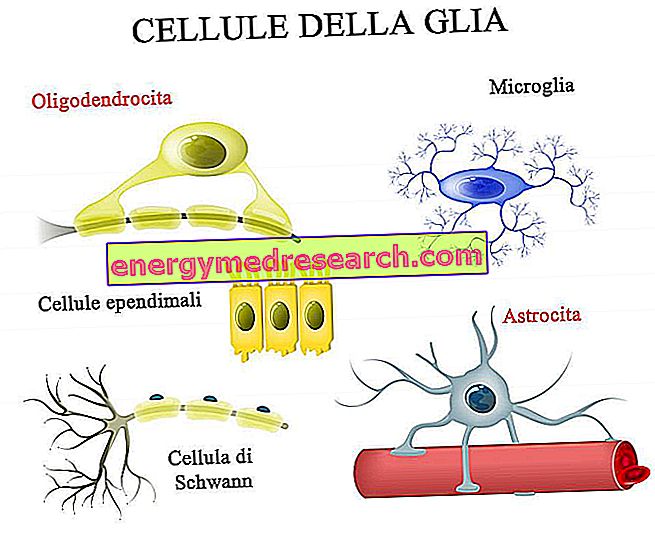Generality
The potential risks associated with excessive sun exposure are now overt and this is why photoprotection is always encouraged. However, many people are unaware of a phenomenon that can accelerate and aggravate sun damage on the skin; this condition, called photosensitivity, consists of an abnormal and excessive skin reactivity to solar (or artificial) radiation.

The following article provides an overview of some of the medical conditions associated with photosensitivity.
Allergy and phototoxic reactions
Photodermatoses represent the clinical expression of an allergic or phototoxic reaction to the sun. These skin diseases are presented with different and clearly identifiable manifestations, but the main characteristic that unites them is a high photosensitivity.
Phototoxic reaction
The phototoxic reaction becomes evident within 24 hours of sun exposure (rapid onset). It mainly manifests itself as an irritation, similar to an exaggerated sunburn, confined to the area of the skin exposed to the sun. Solar radiation reacts with a photosensitizing substance, which can be activated and transformed into toxic compounds, which in turn trigger an inflammatory response on the skin. The extent of the manifestation is strongly influenced by the dose of chemical involved and is independent of the immune system intervention. See photo Phototoxic contact dermatitis.
Photoallergic reaction
In photoallergic reactions, however, the immune system intervenes, so a cell-mediated immunological response is activated. This type of intolerance to the sun seems therefore to express a systemic alteration. Eruptions appear initially in the skin areas exposed to ultraviolet radiation and can sometimes spread even in areas not directly affected by the sun. Photoallergy, as occurs in other allergic manifestations, tends to occur in previously sensitized individuals: repeated exposure to the same allergen, added to exposure to solar radiation, can induce a characteristic reaction with reddened and itchy skin spots, desquamation, and, sometimes, blisters. Allergic reactions occur later than phototoxic ones, generally 24-72 hours after sun exposure, as they require activation of the immune system to manifest the inflammatory response. Often the agent responsible for the allergic reaction is a topically applied drug, but this type of condition does not depend on the dose of the photosensitizing substance, which can also be very small. See photo Photallergic contact dermatitis.
Symptoms and Diagnosis
The levels of exposure required and the severity of reactions are different for each person.
As we saw in the previous chapter, the skin inflammatory response may be related to an allergy or caused by a direct toxic effect. The face, arms and upper chest are the most commonly affected skin areas.
In general, the following symptoms may appear in photosensitive subjects:
- Pain, redness and swelling;
- Urticaria or eczematous lesions, with itchy eruptions or blisters (or boils);
- Hyperpigmentation (dark spots on the skin);
- Systemic complications: chills, headache, fever, nausea, fatigue and dizziness.
Chronic (long-term) photosensitivity leads to scarring and thickening of the skin, as well as increasing the risk of cancer if the etiology is genetic. To define the type of photo-induced reaction, the physician mainly performs an objective examination and collects the complete information concerning the anamnesis. Blood and urine tests may be indicated to detect any related diseases or to exclude other metabolic and genetic causes. Allergic tests (photo-patches or photo-tests) can help identify the substances that can trigger or worsen the condition.
Causes
Photosensitivity and allergic reactions to sunlight can be classified according to their etiology in the following four groups:
| dermatoses | Causes |
Idiopathic photodermatoses | The cause is unknown, but UV exposure produces a well-defined pathological entity, which may include:
|
Exogenous photodermatoses | Photosensitivity is induced by a photosensitizing substance that is applied locally or administered orally, for example some drugs (amiodarone, tetracycline etc.), cosmetics, plants (hypericum), vegetables, fruits, chemicals, perfumes, dyes, disinfectants, etc. . Exogenous (or mediated) photodermatoses include:
|
Metabolic photodermatoses | Photosensitivity is a result of a defect or metabolic imbalance. The most common metabolic disorders involved are:
|
Genetic photodermatoses | These reactions are caused by a pre-existing genetic disease and depend, above all, on deficiencies of natural photoprotection, as in the case of:
|
Secondary photodermatoses
Also known as photoaggravated dermatosis
Some dermatological conditions may worsen following exposure to sunlight: in these cases, photosensitivity is secondary to already existing pathologies, which make the skin extremely susceptible and reactive to the stimulus represented by the sun. Photosensitivity plays a major role in the appearance of clinical manifestations.
Photo-aggravated dermatoses include:
- Lupus erythematosus (especially subacute and systemic forms);
- Dermatomyositis;
- Herpes simplex;
- Darier disease;
- Rosacea;
- Pemphigus;
- Atopic dermatitis;
- Atopic eczema;
- Psoriasis;
- Vitiligo.
Symptoms
How to recognize photodermatoses and sun allergies
Among these skin disorders it is possible to distinguish acute (rapid and sudden onset) or chronic (long term) reactions. Below are some examples.
Acute photosensitivity
- Polymorphic light eruption (or polymorphic solar dermatitis) : it is the most common cause of acute photosensitivity and includes a wide spectrum of reactions. It occurs most commonly before age 30 and mainly affects women. The polymorphous eruption in light arises as a papular or papular vesicular eruption (small serous bubbles) erythematous (reddened skin) and itchy, within hours or days from the start of exposure to the sun, and can last a few days or more weeks . The treatment consists mainly of the use of oral or topical corticosteroids and the preventive application of sunscreens. Antihistamines can relieve itching. The condition generally improves with gradual exposure to the sun, which can lead to greater tolerance to UV rays.
- Solar urticaria : it is a rare disease that usually affects women between 20 and 40 years. It presents a series of typical symptoms of an allergic reaction: itching, burning, wheals and irritations, which develop after a few minutes of exposure to sunlight (within about 5-10 minutes) and usually last a few hours. People with very large affected areas may have associated systemic symptoms, including headache, wheezing, dizziness, weakness and nausea. Solar hives can be treated with antihistamines, corticosteroids and desensitization therapy (phototherapy).
- Subacute cutaneous lupus erythematosus (SCLE) : it occurs with an annular or psoriasiform (eruptive as in psoriasis) eruption, which occurs within a few days after sun exposure and lasts a few weeks. SCLE is treated with corticosteroids for topical or oral use in the acute phase. The management also includes the application of sunscreens and protective clothing. Other possible treatments include thalidomide, antimalarials, retinoids, interferon and immunosuppressants.
- Mediated photosensitivity: the phototoxic and allergic reaction may be the result of the adverse effects of some commonly prescribed topical or systemic drugs. For some individuals, even some sunscreens can cause the problem to arise. The induced reaction can be phototoxic (tissue damage is direct) or allergic (the damage is immunologically mediated). Phototoxic reactions are rapid onset, are more common and are similar to severe sunburn. Allergic reactions tend to resemble allergic contact dermatitis and may have a delayed onset (24-72 hours). Lichenoid reactions, subacute cutaneous lupus erythematosus or pseudoporphyria may also occur. Repeated phototoxic lesions can lead to premature skin aging and an increased risk of cancer. Management involves the use of topical or systemic corticosteroids (if severe), sunscreens (if they are not the cause of photosensitivity) and the limitation of the causative agent (if possible and indicated by the doctor).
Below are some examples of substances that can trigger the different types of reactions:
| Direct toxic effect: |
|
Allergic reactions: |
|
Chronic photosensitivity
Chronic photosensitivity seems to be much less common than in acute clinical expressions. Prevalence is uncertain, as it is probably under-diagnosed. The eruption is usually present throughout the year, but sometimes it is evident especially in the warm months. Exposure to sunlight could amplify the eruption or produce few changes. The key point for diagnosis is that the rash is mainly confined to exposed skin.
- Chronic actinic dermatitis : rare condition, which mainly affects elderly men and is characterized by eczematous lesions on skin exposed to the sun, especially on the scalp, face, back of the hands and chest. It includes various related disorders and often results from an allergic reaction, which leads to persistent photosensitivity. The outbreaks become more severe during the summer months, when the body is exposed to the greatest amount of UV rays. Effective treatment requires rigorous prevention during sun exposure, desensitization with phototherapy or immunosuppressive drugs.
- Actinic prurigo : it is a rare disease, characterized by intensely pruritic papules and nodules, which evolve into scaly patches and scars due to exposure to sunlight.
Unlike other disorders characterized by photosensitivity, photoinduced actinic prurigo may persist throughout the year, with lesions that occur even in winter. Recurrent application of sunscreens is useful, but complete abstention from the sun may be the only fully effective means of prevention. Topical or systemic steroids, antimalarials and thalidomide can also be used.
- Late cutaneous porphyria : it is a rare form of photosensitivity that mainly affects adult males. It presents with erosions (ulcers) and boils after a minor trauma, especially on the back of the hands and forearms. The dosage of urinary porphyrins confirms the diagnosis. The disorder is mainly treated with chloroquine.
- Systemic lupus erythematosus (SLE) : chronic autoimmune disease that often manifests itself with rashes on the face (especially on the nose and cheeks) and systemic symptoms. Lupus-related skin lesions are very photosensitive and, if exposed to the sun, can lead to scarring or depigmentation. The scars that form on the lips must be closely observed, as they could cause squamous cell skin cancer (SCC). Some patients may also develop red scaly patches on the back and chest after sun exposure. Systemic lupus erythematosus aggravated by photosensitivity can be treated with oral corticosteroids or antimalarial tablets; even laser surgery can help minimize scarring and lesion size.
therapies
With some types of dermatosis, doctors can use phototherapy (controlled exposure to light) to desensitize the skin or to help control symptoms. The pharmacological measures are strictly dependent on the type of reaction and the associated medical condition.
In general, the indications include:
- Antihistamines, to reduce the itchy symptoms;
- Steroids, to relieve symptoms associated with inflammation;
- Glucocorticoids (short term), to help control eruptions;
- Immunosuppressants, to suppress the immune reaction in patients who are extremely sensitive to the sun and for the most serious clinical cases.
For those who cannot be treated with phototherapy, doctors can prescribe hydroxychloroquine, thalidomide, beta-carotene or nicotinamide . People needing topical or systemic steroid therapy should be constantly monitored. Also, anyone who is susceptible to photoallergic or phototoxic reactions should keep track of the frequency and duration of symptoms. This information can help you manage the treatment in the most appropriate way.
Prognosis and Complications
Most photosensitivity reactions resolve spontaneously and do not cause permanent damage. However, the symptoms can be severe when there is an underlying disease or when exposure to the sun has been excessive.
The complications can be:
- Hyperpigmentation or dark spots on the skin, even after the resolution of the inflammation;
- Early skin aging;
- Basal cell carcinoma of the skin, spinocellular carcinoma or melanoma.
Conclusions
In some cases, photosensitivity can be a serious problem. Some drugs, such as fluoroquinolone antibiotics, have induced benign and malignant skin lesions, including basal cell and spinocellular cell carcinomas, in animal models. A recent case-control study has provided evidence that photosensitizing agents can increase the incidence of skin cancer also in humans. Since many of the photosensitizing drugs are of vital importance to maintain or restore health and quality of life, it is important to adopt a combination of precautionary measures to avoid direct exposure to the sun and ensure adequate photoprotection.
In this sense, it is possible for example:
- Plan outdoor activities, avoiding the hours when the sunlight is most intense (10: 00-16: 00);
- Frequently apply a high-protection and broad-spectrum sunscreen (for photosensitive individuals at least one SPF 30 or higher is recommended);
- Wear sun protective clothing, including wide-brimmed hats and sunglasses.



